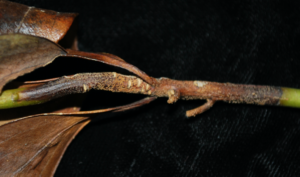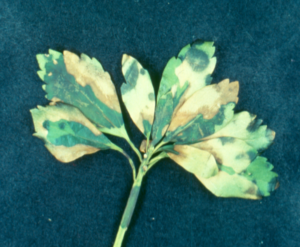Last week’s post concerning leaf spot diseases in turfgrass, and a few samples of dead pachysandra in the lab this week, got me thinking about how much I hate pachysandra. Hate might be too strong a word for a plant, but like Neumann and Jerry, this subshrub is my nemesis. Some of you may have heard me tell stories about trying to rid my home garden of pachysandra and finding it impossible to kill, but subsequently planting several hundred plants at my late-mother’s house only to see them all die of disease, so surely you can empathize with my perspective!
Pachysandra can grow in deep-shade areas, so it is well-suited and popular as a ground cover for shade gardens. The most commonly used species is P. terminalis, the Japanese spurge, which is an aggressively spreading evergreen. It is very deer-resistant, which unfortunately, also means that it gets planted into many New Jersey landscapes and gardens for that reason alone.
Deep shade usually means a wet site and that is where the disease issue comes in. Pachysandra, especially P. terminalis, is susceptible to the fungus Pseudonectria pachysandricola, which is the cause of the disease Volutella Leaf and Stem Blight. Leaf and stem blight is the most destructive disease of pachysandra in New Jersey.
Numerous patches of wilting and dying plants in a landscape bed are often the first indication that Volutella blight is in active in the bed. Both leaves and stems are attacked by the causal fungus. Leaves develop irregular tan to brown blotches, often with concentric circles of light and darker zones and sometimes with dark-brown margins. These blotches gradually increase in size until the entire leaf turns brown or black and dies. Stem cankers usually develop and cause whole plants to die back. Stem cankers can appear at any point on the stem and begin as greenish-brown and water-soaked lesions that eventually turn brown or black as the stems shrivel. As the fungus girdles the stem, sizeable parts of the plant beyond or above that point turn brown and die. Plant death from stem infections can be quite extensive, so the planting appears to melt away in a manner very much like turfgrass subjected to leaf spot and melting out.

Photo 3: Melting out of a Pachysandra planting due to Volutella Leaf and Stem Blight. Photo: Richard Buckley, Rutgers PDL
During wet, humid weather, affected plant parts can be covered with reddish-orange, cushion-like fungal fruiting bodies, called sporodochia. Conidia (asexual spores) produced in the sporodochia disseminate the fungus within the planting. They are easily spread by rain splashing and wind, or mechanically by people working the bed during wet weather. If blight is suspected, but fruiting bodies are not evident, place suspect plant material in a plastic bag with a moist paper towel. In a day or two fruiting bodies will develop that can be seen with a hand-lens.
Weak or injured plant material is much more susceptible to the disease than healthy tissue, so damage may be very severe when plants have been stressed by excessive sunlight, winter injury, drought, or insect attack. Spread of the fungus is also more rapid in dense plantings, where heavy mulches are used, or in beds with residual leaf debris. Planting beds subject to regular overhead irrigation often have more disease activity.

Photo 5: Euonymus scale on Pachysandra. Photo: Richard Buckley, Rutgers PDL
Normally this disease does little damage to vigorous plants, thus providing good growing conditions is one of the most important control measures. Begin by selecting healthy, disease-free planting materials. Plant in a well-drained soil and on sites with suitable sun/shade exposure.
Control of the disease in an infected planting bed begins with good sanitation. Remove and destroy all of the affected plants and plant debris. Use a regular lawn mower set at a 1 to- 2 inch cutting height to mow the affected area. Catch all of the debris in a bag and discard. Be sure to mow an area well outside of the diseased patch. A little nitrogen fertilizer will help the remaining plants to fill in the mowed area.
Prune trees and shrubs to increase light penetration and air circulation in and around the site to help keep it dry. Avoid overhead irrigation and avoid wet foliage whenever possible. If irrigation is needed to avoid drought stress, then water early in the day, so the foliage can dry as quickly as possible.
On high value landscapes, and after sanitation and moisture management issues are corrected, fungicides may be an effective addition to a management program: make applications of chlorothalonil, copper, mancozeb, myclobutanil, or thiophanate-methyl at the first sign of disease and repeat at label specified intervals and rates.
I’ll leave you with this existential question: are you sure you really want to plant pachysandra? How about a hosta or something instead?




